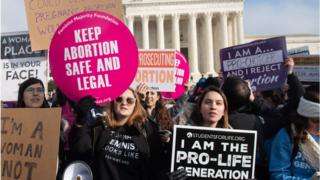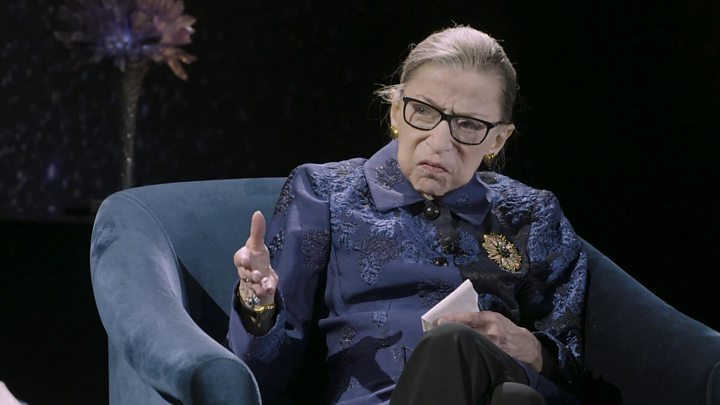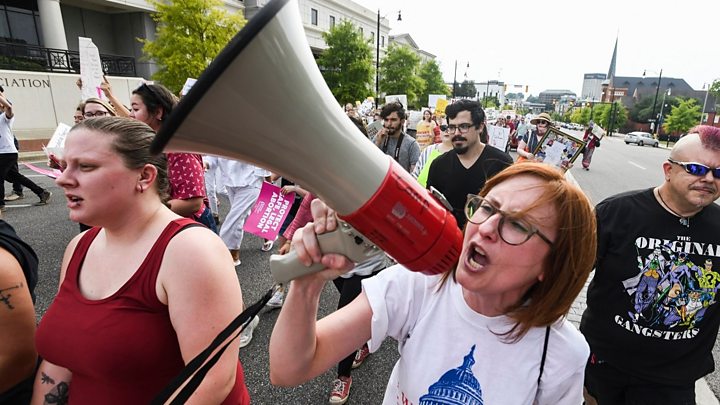Roe v Wade: What is US Supreme Court ruling on abortion?
 Image copyright
Getty Images
Image copyright
Getty Images
Abortions were made legal across the United States in a landmark 1973 Supreme Court judgement, often referred to as the Roe v Wade case.
That momentous decision now back in the spotlight as the US Senate holds confirmation hearings on a new justice for the top court.
President Donald Trump has nominated Judge Amy Coney Barrett.
Judge Barrett's approval would cement a 6-3 conservative majority on the nine-member top court, shifting its ideological balance for potentially decades to come.
Abortion has been a lightning-rod for opinion in the US for decades, and activists on both sides believe this is a pivotal moment.
- How do Trump and Biden's stances compare?
- Who is Trump's Supreme Court pick?
- Amy Coney Barrett in her own words
What is Roe v Wade?
The 1973 Supreme Court ruling legalised abortion in the US.
By a vote of seven to two, the court justices ruled that governments lacked the power to prohibit abortions.
The court's judgement was based on the decision that a woman's right to terminate her pregnancy came under the freedom of personal choice in family matters as protected by the 14th Amendment of the US Constitution.
The ruling came after a 25-year-old single woman, Norma McCorvey under the pseudonym "Jane Roe", challenged the criminal abortion laws in Texas that forbade abortion as unconstitutional except in cases where the mother's life was in danger.
Henry Wade was the Texas attorney general who defended the anti-abortion law.
Ms McCorvey first filed the case in 1969. She was pregnant with her third child and claimed that she had been raped. But the case was rejected and she was forced to give birth.
However, in 1973 her appeal made it to the US Supreme Court where she was represented by Sarah Weddington, a Dallas attorney.
Her case was heard on the same day as that of a 20-year-old Georgia woman, Sandra Bensing.
They argued that the abortion laws in Texas and Georgia ran counter to the US Constitution by infringing women's right to privacy. They won their case.
How did the case change women's rights?
The case created the "trimester" system that:
- gives American women an absolute right to an abortion in the first three months of pregnancy
- allows some government regulation in the second trimester of pregnancy
- declares that states may restrict or ban abortions in the last trimester as the foetus nears the point where it could live outside the womb
Roe v Wade also established that in the final trimester a woman can obtain an abortion despite any legal ban only if doctors certify it is necessary to save her life or health.
What restrictions on abortion have been introduced since?
In the almost half-century since Roe v Wade, anti-abortion campaigners regained some lost ground.
In 1980 the US Supreme Court upheld a law that banned the use of federal funds for abortion except when necessary to save a woman's life.
Then in 1989 it approved more restrictions, including allowing states to prohibit abortions at state clinics or by state employees.
The biggest impact came from the top court's ruling in Planned Parenthood v Casey in 1992.

While upholding the Roe v Wade judgement, it also established that states can restrict abortions even in the first trimester for non-medical reasons.
The new laws must not place an "undue burden" on women seeking abortion services. However, it is the woman and not the authorities who have to prove that the regulations are damaging.
As a result many states now have restrictions in place such as requirements that young pregnant women involve their parents or a judge in their abortion decision. Others have introduced waiting periods between the time a woman first visits an abortion clinic and the actual procedure.
The result of these restrictions is that many women have to travel further to get an abortion, often across state borders, and pay more for them. According to the pro-choice movement, poor women are penalised most by these restrictions.
When could Roe v Wade be considered again?
The court can only tackle Roe v Wade if it takes on a case which allows it to revisit federal laws protecting the procedure.
That's why anti-abortion politicians in states including Alabama, Georgia and Ohio have introduced severely restrictive laws and even abortion bans which they know are unconstitutional.
They hope to force a legal challenge which will ultimately make it to the Supreme Court.

Overturning Roe v Wade would not make abortion illegal, it would just allow each state to determine its own rules.
When asked if the Supreme Court might consider the abortion issue soon, President Trump said "it's certainly possible".
He added: "Maybe they would do it in a different way. Maybe they would give it back to the states. You just don't know what's going to happen."